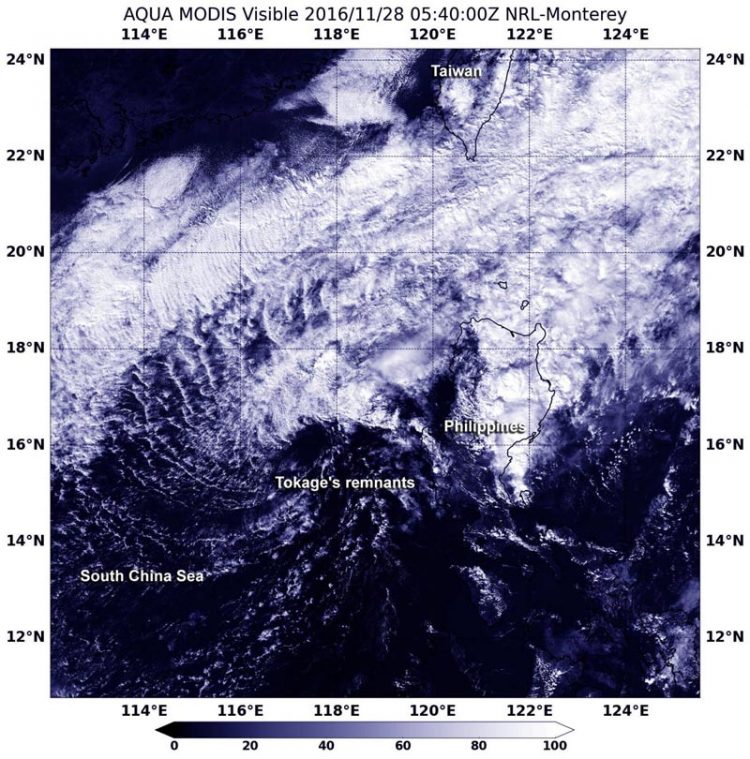NASA's Aqua satellite sees remnants of Tropical Cyclone Tokage

NASA's Aqua satellite captured a visible image of Tokage's remnants in the South China Sea on Nov. 28 at 1240 a.m. EST (540 UTC). Credit: NASA Goddard MODIS Rapid Response Team
The Moderate Resolution Imaging Spectroradiometer or MODIS instrument aboard NASA's Aqua satellite captured a visible image of Tokage's remnants in the South China Sea on Nov. 28 at 1240 a.m. EST (540 UTC).
The image showed that the bulk of clouds associated with the remnants were pushed north of the center of circulation.
On Nov. 28 at 4 a.m. EST (0900 UTC), the Joint Typhoon Warning Center (JTWC) issued their final warning on Tokage. At that time Tokage had maximum sustained winds near 28.7 mph (25 knots/46.3 kph) and they were weakening.
The storm was located near 16.3 degrees north latitude and 116.7 degrees east longitude, about 242 nautical miles west-northwest of Manila, Philippines. It was moving to the southwest at 19.5 mph (17 knots/31.4 kph).
JTWC noted that “animated multispectral satellite imagery reveals that the remnants of Tokage has embedded within the northeasterly cold surge which has caused it to accelerate southwestward and almost completely unravel.”
The remnants are expected to continue to move to the southwest and completely dissipate.
Media Contact
All latest news from the category: Earth Sciences
Earth Sciences (also referred to as Geosciences), which deals with basic issues surrounding our planet, plays a vital role in the area of energy and raw materials supply.
Earth Sciences comprises subjects such as geology, geography, geological informatics, paleontology, mineralogy, petrography, crystallography, geophysics, geodesy, glaciology, cartography, photogrammetry, meteorology and seismology, early-warning systems, earthquake research and polar research.
Newest articles

Silicon Carbide Innovation Alliance to drive industrial-scale semiconductor work
Known for its ability to withstand extreme environments and high voltages, silicon carbide (SiC) is a semiconducting material made up of silicon and carbon atoms arranged into crystals that is…

New SPECT/CT technique shows impressive biomarker identification
…offers increased access for prostate cancer patients. A novel SPECT/CT acquisition method can accurately detect radiopharmaceutical biodistribution in a convenient manner for prostate cancer patients, opening the door for more…

How 3D printers can give robots a soft touch
Soft skin coverings and touch sensors have emerged as a promising feature for robots that are both safer and more intuitive for human interaction, but they are expensive and difficult…




















